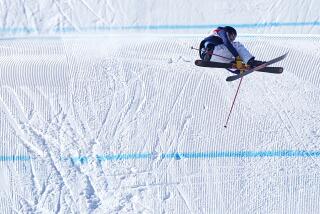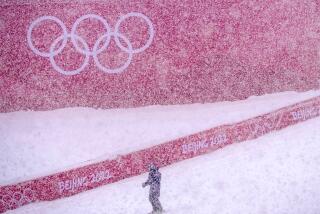Women’s Ski Tour Turns Up a Flip Side
- Share via
The women’s portion of the World Cup ski tour, always separate and never equal to the men’s, could become a media darling this season, thanks to a controversial new competition format designed to boost sagging television ratings for ski racing.
The format change could also strengthen the relationship between the women’s tour and the United States, where the women have become almost as popular as the men.
The International Ski Federation (FIS) has decided that the women will use the controversial “flip 30” second-run format in all gate races this season, ensuring that none will be decided until the last racer comes down the hill.
The men’s tour will use the new format only in December, reverting to the traditional “beebo” format in January.
Under “beebo,” the five fastest first-run finishers in a slalom or giant slalom begin the second run in reverse order. The fastest racer from the first run, therefore, is fifth out of the gate. After that, the racers compete in order of their times in the first run.
The “beebo” method, according to racers and organizers alike, is the most equitable for all concerned. The top 15 skiers--seeded No. 1--get optimal skiing conditions for both runs; those outside the first seed are rewarded for a good first run by starting sooner in the afternoon.
But that method, frankly, is boring to a very important observer--television. Except in rare cases, a winner under the “beebo” format is known only five racers into the second run.
Hence, the “flip 30” idea. The 30 fastest in the opening run compete in reverse order in the afternoon. It is similar to a golf tournament, in which the lowest scorers start last.
The appeal for the fan and TV is obvious, because a winner won’t be known until the last racer has skied the course. But racers generally want nothing to do with the scheme, because the comparison with golf doesn’t hold up for long.
Late starters in a golf tournament still find lush conditions, the biggest problem usually little more than spike marks on the greens. Ski slopes break down much quicker. Skis slashing along the same snowy path create ruts, and the 20th racer down a soft course could literally be skiing in a ditch.
Adoption of the “flip 30,” therefore, will put greater pressure on resorts to prepare racing trails that can withstand the rigors of 30 skiers. It is that pressure to prepare that could move the women closer to American race sites.
“It wouldn’t be so bad if we had conditions like we have in North American,” said Perrine Pelen of France, a premier slalom skier. “But it won’t work in Europe because they don’t have the snow, and they don’t groom the courses as well.”
Europe has, for the most part, refused to embrace the latest course-preparation technology and relied on natural snow.
In North America, skiing is big business. Resort managers realized long ago that skiers will go only where there is snow, and so they invested heavily in snow-making and course-preparation equipment. They are accustomed to preparing trails capable of withstanding a full day of skiing, so it’s relatively easy for traditional World Cup sites like Waterville Valley, N.H., Aspen and Vail in Colorado, Park City, Utah and Heavenly Valley, Calif., to provide excellent courses for racers.
“We can give them that,” said Tom Corcoran, director at Waterville Valley and a former elite racer. “American resorts are far ahead of Europe in the use of artificial snow and in course grooming.”
As proof, Corcoran pointed to a women’s slalom race last spring at Waterville in which Sweden’s Camilla Nilsson, who started 39th, finished sixth.
“When No. 39 finishes sixth, that shows it was a fair course for everybody,” he said. “We’re very proud of that.”


